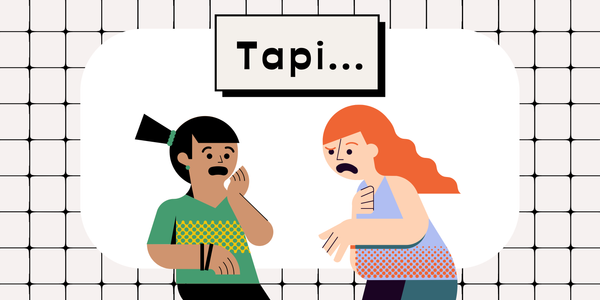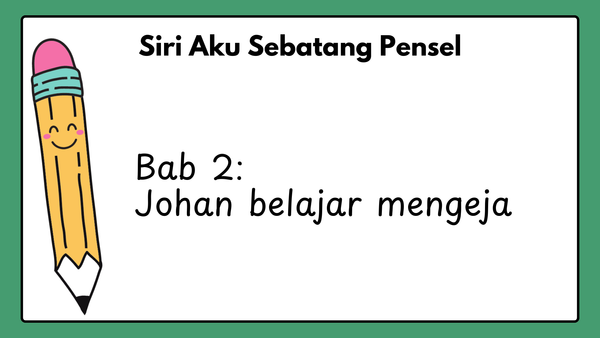How to learn Malay
...here are a few tips to equip yourself with tools to learn Malay!

As with all languages, while interest may initially spur you to learn them, effort and drive are the necessary ingredients for long-term learning. It can be tedious, but it can also be fun! Assuming you don’t have any tutors or Malay-speaking friends to be your conversation partners, here are a few tips to equip yourself with tools to learn Malay!
Total Beginner in Malay
Starting any new endeavour requires strong basic knowledge. In order to gain that, the best and fastest way is to use a textbook or any resource that teaches you the basics. Preferably, one should have a grasp on how to read and pronounce Malay words as well as some common vocabulary and grammar before diving head-on into immersive learning.
Therefore, you've come to the right place. Whether you want to speedrun and be fluent asap or just want to enjoy the experience of learning a new language, this flashcard set ⬇️ is the perfect introduction to Malay for you.

When you're ready to start learning Malay, use these free resources to complement the flashcard set:
1️⃣ Kamus Dewan Dalam Talian (Online Malay Dictionary) V1 & V2
I can’t overemphasise the importance of easy access to a good dictionary. Fortunately, Kamus Dewan has an online Malay-English corpus that is quite all-encompassing, including proverbs and some technical terminologies. While it’s not been updated with the latest edition of the authoritative dictionary, the Kamus Dewan Perdana, it’s still very useful and largely reliable.
You can also download the app, Kamus Pro, on Google Store if you need to use the dictionary offline.
P/S: there are 2 versions of the website. I find version 1 easier to navigate, but it’s up to you, so I’ve linked both.
2️⃣ Speak Malay Like a Local
What I like about Sierra Lisse in her Speak Malay Like a Local series are her very clear and well-thought out teaching methods. Simply said, they’re easy to understand as she breaks down the sentences introduced, so even beginners are able to follow along quite well. She has also touched upon a wide range of topics and teaches practical Malay useful in different situations. Highly recommended if you prefer watching videos for learning!
3️⃣ Malay 101 Course
This website by pgoh13 is such a blessing! The creator has compiled the basics of the Malay language and presented them in easy and digestible lessons that are highly comprehensive. This website also frequently does some comparing and contrasting between the Malay language and the Indonesian language. I would say this website is a good stepping stone for Malay learning.
Once you feel somewhat comfortable with the basics, it’s probably easier to delve into other types of learning tools that are more fun and engaging.
Malay Beginner to Intermediate
Now that you know some basics in Malay, you can maintain your interest in the language by engaging with things made for natives. This is also a litmus test to gauge where you are in your language-learning journey. But how can you learn while immersing yourself in Malay content? The following are some helpful tips.
4️⃣ Watching Shows while Shadowing
I know a number of people who have found success in learning languages through consuming media of the target language. It’s fun, it’s a good time and it’s relaxing, right? However, to make it a more effective learning tool, I’d recommend you to actively shadow the dialogues you hear. Wait, shadow?
A lot of you may already be familiar with this technique. Shadowing is, at its simplest, a technique that requires you to repeat what you hear.
The objective of this exercise is to familiarise yourself with the way the language is spoken; where the natural emphases occur, where the pauses appear, and how natural speech sounds. By repeating aloud, your tongue will also soften to the way the language rolls off of it, and your ears will learn how to parse meaning from the sounds.
A quick google search will reward you with a slew of articles on the best way to implement this technique, so you can apply this accordingly as long as it works for you. Nevertheless, I’ll give you a version I’ve tweaked to my liking. This requires setting up a few things on your laptop before getting into the technique:
- Find a Malay show you like on Netflix.
- Download the Subadub Chrome Extension.
- Start watching and listen carefully.
- Repeat what you hear (or what you think you’ve heard). Stop after a few dialogues, or after 1 minute or 5. Adjust this to your level.
- Go back to the start, now watch with both the Malay and your native language subtitles.
- Repeat the dialogues but now while reading the subtitles.
- Go back to the start, and repeat without the subtitles.
Yes, it sounds laborious. But in order to make watching TV an active learning tool, this can be one of the more effective ways. Passive watching can be good too, but it will take you longer to achieve any sort of improvement.
I’d suggest doing the shadowing technique for a select part of a show (1-5 minutes out of a 30 minute show, for example), and watch the rest normally as a reward. The more you do this, the more steps you can remove and personalise. And at a certain stage, you can just shadow all the way without pausing or flipping the subtitles on and off. At the end of the day, do what suits you and your learning style!
5️⃣ Listening to Malay Songs
Songs can be a great way to retain vocabulary without forced cramming and usually stays with you longer due to the nature of music that strongly binds to our memories.
Of course you can just memorise songs to sing along and enjoy, which will still give you the opportunity to familiarise yourself with the sounds of the language and its words, but you can also go the extra mile and memorise the meaning of each word in the lyrics.
For the latter, children’s songs are great because of how short and repetitive they are. Don’t scoff at them just because they’re for children! It’s precisely because they’re made for children that it’s useful for learning basic words.
For example, this song, “Jom Bersihkan Diri”, from Didi & Friends repetitively sings about one’s morning routines, incorporating household terms, common adjectives as well as natural speech. They have many other songs that are easy to understand and sing along to, and a few are quite addictive (I totally don’t hum these songs in private)!
However, it’d be nice to listen to some real music as well. Gasp! Anyway, for normal songs, I think the best way to approach them without burdening yourself with remembering the meaning of each word is to focus on specific verses that you love or the chorus. And remember, you don’t have to perfect one song to a tee to start enjoying and memorising other songs.
Here’s a list of a few songs that might be of interest as a starter. Enjoy!
Sudirman’s Apa Khabar Orang Kampung
Meet Uncle Hussain’s Lagu Untukmu
6️⃣ Reading Comics in Malay
I know how daunting reading in a new language can be. You either feel too inadequate to ever read anything written for native readers, or overestimate your skills and tackle something too much only to end up giving up halfway.
To avoid that, comics are the best introduction to reading, not only for all the cute drawings that fill up the page, but also the format of the writing: they’re mostly dialogues!
In Malaysia, dialogues in comics are usually in colloquial (spoken) Malay, so they may not always be grammatically accurate, but they are good indicators of native speech.
There’s also a category of comics in Malaysia that uses High Malay (Standard Malay/Bahasa Melayu Tinggi).
The language in these comic books adheres to Malay grammar but still sounds casual. These are also great reading materials that will prepare you to eventually read materials with formal written language, like academic papers and the news.
You can get comics of a variety of genres published by Gempak Starz, which are beloved by many Malaysians due to its usually humorous nature, or you can read free comics online at MatKomik, a platform for amateur comic artists to publish their materials. The quality might vary, but I saw a few good gems on it.
Comics that use BMT can be found at Komik-M, the website of a publishing company that releases a great range of series akin to a clean version of the shounen/shoujo manga genre.
And last but not least, this subsection would be amiss to leave out the legendary Malaysian comic, Kampung Boy, or Budak Kampung by Lat. It’s a childhood favourite among many, and is a lovely peek into the village life of a Malay Boy. It’s published in many languages, so it could be a great tool for learning through side-by-side translation.
Alright, that’s about it for now. While some of these may come across as common sense, a lot of language learners fall into the trap of focusing only on one tool or one part of learning instead of diversifying their methods. Hence, my recommendation is to try out simple materials as above while being fully aware that they can only be active learning tools if you treat them like it.
On another note, feel free to crossover to native materials whenever you feel ready. You don’t need to finish a certain set of lessons or YouTube videos before attempting to watch Malaysian cartoons or reading Malay books. It is all up to you!
To advanced learners, treat Malay like your native language and don’t be afraid to speak, read and listen. To all learners, know that progress is never linear and growth requires time, so even though it can feel like a chore at times, enjoy the journey of discovering a new language that will unveil a window to not only a new group of people with its history and culture, but also to your own.
Different areas will hold different creatures and have deeper bottoms. Do not feel intimidated by unfamiliar words and unknown phrases. Remember, swimming through the waves is all about feeling the water wash over you.
Comment down below if you have any questions :)





